Days Gone By Stories from the Trailblazing Years of Yamaha Motor
1The Seven Samurai and the Red Dragonfly
I joined Nippon Gakki thanks to the recommendation of the company’s managing director, Aisa-san, who actually was an upperclassman from my school days. Upon joining, I was told, “Nippon Gakki has never made a mid-career hire before; you’re the first.” At the time, the company was just starting to develop motorcycles as its next product category and they were considering hiring some engineers with a wide variety of experience, so I was welcomed with open arms.
It was summer when I entered the company. When I went to the president’s office to introduce myself, he was sitting there wearing only an undershirt and pants. The simple response I got was, “Okay. Do your best.”
Sitting there in just his underwear cooling himself with a sensu (folding fan) and saying so few words, he didn’t seem at all interested in me. After all I’d heard about the legendary Kaichi Kawakami and then having met the real man, he seemed rather strange to me at the time.
I later learned that Kaichi Kawakami had stepped down from his role as president a few years ago due to illness and was on his sickbed when I joined the company. I had actually introduced myself to his son, President Genichi Kawakami. Now he was quite a demanding president to work under, but a man I would learn a lot from over the coming years.
I was assigned to the prototype workshop in the research department. The prototype workshop was where we were developing motorcycles and though it was technically in the research department, we didn’t interact much with the other sections.
The team had Nemoto-san, Anma-san and Takeuchi-san in charge of the engine, the chassis engineers were Naito-san and Kaneko-san, and Toyama-san was in charge of electrics. I joined the chassis group, making seven of us in all. Together, we did all the development work for Yamaha’s first motorcycle. I guess you could say we were the Seven Samurai of motorcycle development!
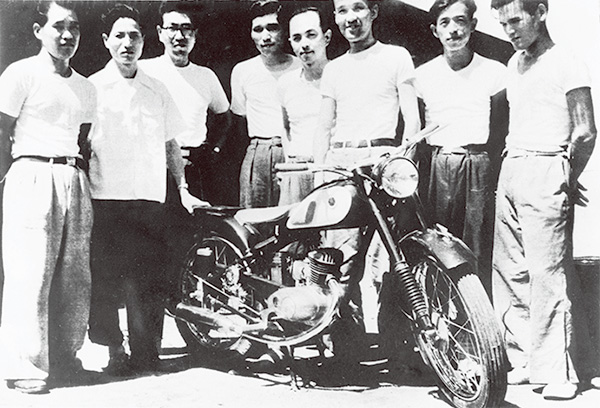
The “Seven Samurai” with the first YA-1 prototype
Our first model was the 125cc YA-1. It was modeled after the German DKW RT125 and they were already making model sketches when I joined. I was put in charge of designing the frame while the bike’s exterior was designed by Shinji Iwasaki and Kenichi Shibata (they would later form the GK Group) with input by Professor Iwataro Koike from the Tokyo National University of Fine Arts and Music (currently the Tokyo University of the Arts).
For the exterior, we changed the cross-sectional design for the chain case and fenders, and made some refinements to the shapes of the smaller parts based on the team’s shared ideals. The biggest effort we made was with the machine’s color scheme.
Iwasaki-san and Shibata-san wanted to use colors to create a totally new visual sensation. One of the favorite sweets of young women at the time was cream-filled chocolate; I remember it being a symbol of dreams and romance back in those days. Because the color on the wrapper of this Meiji chocolate was very close to that envisioned by the designers, they decided to use it for the YA-1. The base color for the whole chassis was a reddish chocolate mix while the fuel tank got a two-tone finish with a cream white. Users at the time were used to seeing all-black motorcycles, so the YA-1 had a new kind of visual presence that not only helped spread its fame, but also won it the Aka-tombo (“Red Dragonfly”) nickname.
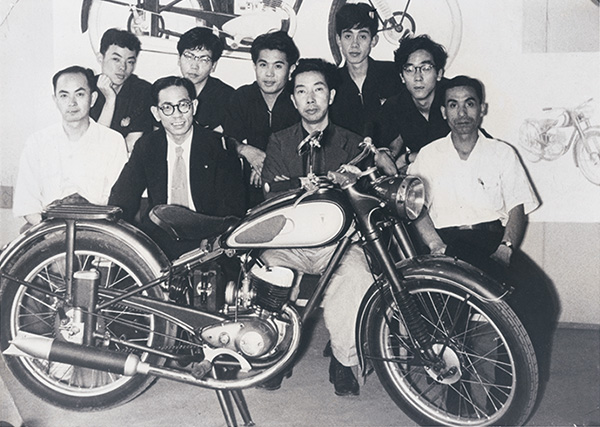
The members of GK that designed the YA-1
2We Become a Motorcycle Company
Even with something to serve as a point of reference, creating a motorcycle for the first time was quite a difficult job. You can measure shapes and dimensions, but the question of how to bring out performance remains. For example, in order to measure the spring characteristics for the front fork, we had to start by fabricating a measuring jig, and we had to do the same to measure the strength of the frame. To check how the frame was reinforced inside and make judgments, we went so far as to use an X-ray machine at Shizuoka University to take photos.
President Kawakami was very passionate about developing motorcycles, and when we started working on the first prototype, he visited the workshop daily to give instructions. All seven of us on the development team worked until late at night every day. We ate dinner at the company and seldom returned home before eleven or twelve at night.
But even if you work with steadfast care and diligence as we did, it’s still not easy to surpass the original. However, because our sample was a well-known and high-quality machine, our first 125cc Yamaha motorcycle turned out to be a pretty good first attempt. The first prototype was completed on August 31, 1954. Work on the chassis had started three months after the engine, so that first prototype was finished only about three months after the technical drawings were made.

The author on the first YA-1 prototype
The completion of the first prototype marked the beginning of testing. Enlisting three of the company’s guards to be our team of test riders, we came up with a course to take around Lake Hamana and they rode day and night to carry out a 10,000 km test. After confirming the machine’s durability, President Kawakami himself tested the bike with us riding along with him, traveling to and up Mt. Norikura, then through Nagano Prefecture and the Asama Highlands before heading to Tokyo.
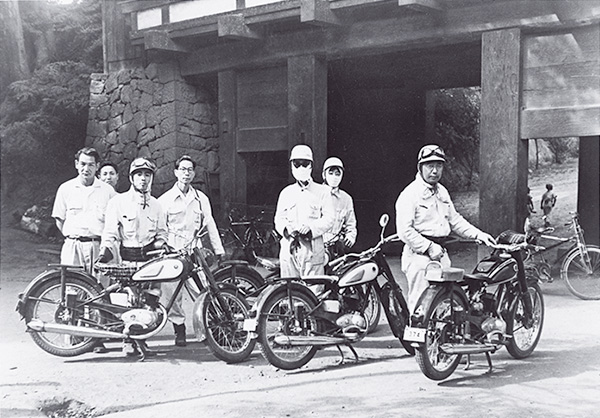
While traveling from Mt. Norikura to the Asama Highlands, the test team stopped by the remains of Komoro Castle

On the way back from the Asama Highlands, the group visited a dealership in the city of Ueda
At our first-ever race, the 3rd Mt. Fuji Ascent Race, we dominated by not only winning the 125cc race but also taking seven of the top ten finishing spots. This established Yamaha’s reputation for high performance and high quality as well as deepened our own understanding of what motorcycles are.
Full-scale production of Yamaha’s first motorcycle, the YA-1, began in January 1955 at Nippon Gakki’s Hamana Factory. Six months later on July 1st, Yamaha Motor Co., Ltd. was established as a group company of Nippon Gakki with 30 million yen in capital, and all motorcycle-related operations from then on were carried out there.
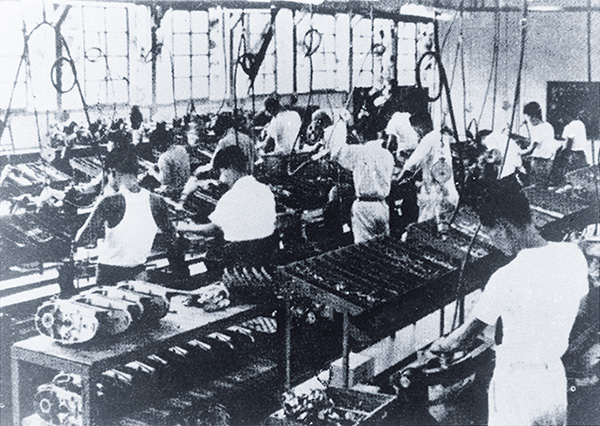
The production lines at the Hamana Factory in 1957
3Creating a New Motorcycle on Our Own
Planning then began for the follow-up model to the YA-1, the 175cc YC-1. Encouraged by the success of the YA-1, we began development with the same basic focus of referring to the similarly copyright-free DKW RT175, and we decided that GK would again handle the exterior design.
Thanks to our experience with the YA-1, development of the new machine proceeded smoothly and the result was very satisfactory. Basically, the same team carried out the same tasks over again.
Production of the YC-1 began in February 1956, just one year after production started for the YA-1. Around that time, we started planning our next model, the 250cc YD-1.
Deciding that it was best for the development team to be located somewhere separate from the factory to better focus on our tasks, we moved the workshop into a concrete warehouse behind Nippon Gakki headquarters. It was here that the Yamaha Technological Research Institute would later be built.
On the 1st floor, we installed a dynamometer for engine testing while the design and engineering was done on the 2nd floor (complete with spider webs). The small team was made up of Iwasaki-san from GK for the exterior design, me and Kaneko-san for engineering the chassis, and Nemoto-san, Anma-san and Takeuchi-san handling engine design.
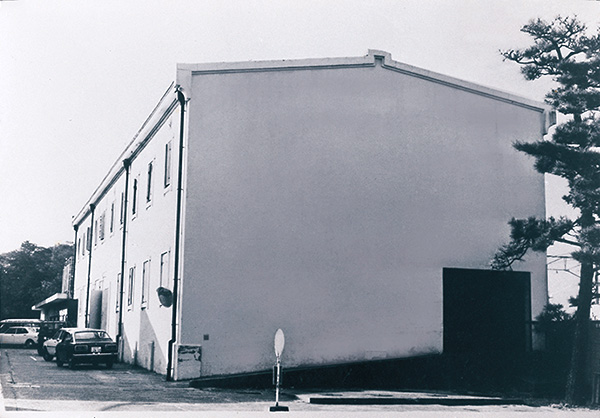
Nippon Gakki’s metals research lab, Tokyo and Hamamatsu research labs and research department at its silkworm cocoon warehouse were eventually consolidated as the Yamaha Technological Research Institute established in 1959
We initially planned to create the YD-1 by using the German Adler MB 250 as a model, but we wanted to build a new motorcycle from the ground up by ourselves and using our own ideas. Because we engineers felt this way and GK did as well, I went with Iwasaki-san to see President Kawakami and got straight to the point:
“Let us build our own original motorcycle this time.”
“If that’s what you want to do, then give it a shot,” he said.
We were overjoyed at getting his permission, but it was afterwards that things would get tough. Now that we’d gotten exactly what we had asked for, we couldn’t make excuses for anything but our best efforts, so we put everything into our work.
4Our Ideals Give Birth to the YD-1
Previously, we’d measure the dimensions of the reference bike and create technical drawings from them. That was the bulk of our work and we didn’t have to worry about the bike’s overall layout, where this part should go or fit, how big it should be, etc. Design-wise, we made changes to the curves of the fenders, the shapes of the fuel tank and other parts, and then spent more time thinking about the overall color scheme.
So when building the YD-1 as a Yamaha-original bike, the engineers worked very closely with the designers from GK. When we weren’t sleeping, we were constantly engaged in face-to-face discussion—and plenty of heated arguments—over every detail.
But eventually, we engineers and the designers reached some common guiding principles: proper design begins with a machine’s functions and should be born out of the necessity of said functions. What are we targeting with the bike? What should the bike’s structure be and what levels of performance are needed to meet that target? The styling and exterior design we can create within that pursuit is what will result in a product that can truly express what we’re trying to create.
Based on these principles, the motorcycle we envisioned began to take shape.
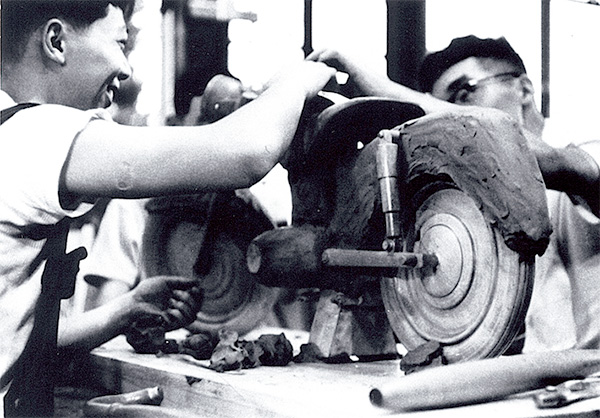
The design team using clay and wood to create a design mock-up
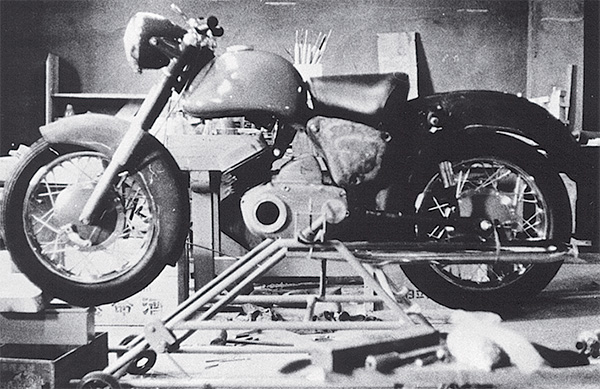
A complete full-scale design mock-up of the YD-1
In the market at that time, most motorcycles had chassis rather large for the low engine output they had because they were built mainly for transporting loads. However, after lengthy discussions on the future direction of motorcycles and their true essence, we came to the conclusion that a motorcycle should be lightweight, agile and powerful. In other words, we all agreed it should be sportier than what was available then.
Accordingly, we designed the YD-1 to be as compact and agile as possible, and fitted a powerful engine that we specifically engineered to improve ride stability and handling characteristics. As a result, I think the YD-1 was a revolutionary model that triggered the transformation of Japanese motorcycles from utilitarian vehicles to sports machines.









